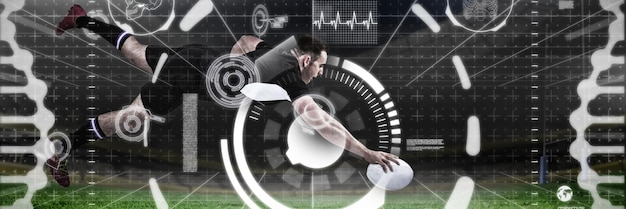FIFA’s New Transfer System: Impact on US Player Acquisitions (2025 Guide)

The FIFA’s new transfer system, set to fully impact player acquisitions by 2025, is poised to reshape how US players move within the global football market, focusing on increased transparency, improved stability for developing talents, and altered dynamics for clubs seeking American prospects.
Delving into the evolving landscape of global football, particularly for US talent, requires a clear understanding of regulatory shifts. This guide offers an in-depth exploration, analyzing the impact of FIFA’s new transfer system on US player acquisitions: a 2025 guide designed for stakeholders ranging from scouts to aspiring athletes.
Understanding the FIFA Football Agent Regulations (FFAR)
The FIFA Football Agent Regulations (FFAR), effective from October 2023 but with a transitional period extending into 2025, represent a significant paradigm shift in the global football transfer market. These regulations aim to bring greater transparency, stability, and integrity to an often opaque and complex system. Their core intent is to standardize practices, protect players, and regularize the roles and remuneration of football agents worldwide.
At its heart, FFAR reintroduces a licensing system for football agents, ending a period where a vast number of individuals operated without formal oversight. This means agents must now pass an examination, meet eligibility criteria, and adhere to a strict code of conduct. The re-regulation is a direct response to concerns over excessive agent fees, conflicts of interest, and illicit practices that have, at times, undermined the sport’s integrity. For US player acquisitions, this newfound structure introduces a more formalized pathway, potentially impacting how American talents are scouted, negotiated, and ultimately transferred.
The regulations also introduce caps on agent commissions, a pivotal change. For instance, an agent representing a player earning less than $200,000 annually can only receive 5% of the player’s remuneration. For higher-earning players or when acting on behalf of the club, the cap generally ranges from 3% to 6%. This shift is designed to reallocate funds back into the sport, benefiting clubs and players, rather than inflating agent earnings. The long-term implication is a more sustainable financial ecosystem for player development and transfers, particularly relevant for emerging markets like the US.
Key Pillars of FFAR and Their Implications
Understanding the fundamental components of FFAR is essential for grasping its full impact. These regulations extend beyond mere licensing, encompassing critical areas designed to reform the transfer landscape.
- Reintroduction of Agent Licensing: Agents must now acquire a FIFA license, ensuring a higher standard of professionalism and ethical conduct. This will likely reduce the number of informal agents, streamlining the process for players and clubs.
- Commission Caps: Strict limits on agent fees aim to prevent exorbitant charges, ensuring more money remains with players and clubs. This could particularly benefit younger, less established US players who are more susceptible to disproportionate fees.
- Prohibition of Dual Representation: Agents are generally prohibited from representing both the player and the buying club in the same transaction, mitigating conflicts of interest. This enhances transparency and fairness in negotiations.
- Mandatory Written Contracts: All representation agreements must be in writing and registered with FIFA, providing clarity and legal recourse for all parties involved. This institutionalizes accountability within the transfer process.
Moreover, FFAR mandates that all transfer activities involving agents be conducted through the “FIFA Agent Platform.” This digital platform serves as a central hub for registering agents, contracts, and transfer transactions, thereby enhancing transparency and traceability across the global market. The collected data is expected to provide invaluable insights into market trends, helping FIFA monitor compliance and identify potential anomalies.
For US player acquisitions, the increased transparency and standardized practices orchestrated by FFAR could potentially lead to a fairer market. It might empower US clubs, agents, and players by providing a clearer framework for engaging in international transfers, reducing the risks associated with less regulated environments. The regulations are not without their critics, particularly regarding the commission caps, with some agents arguing they stifle competition and hinder their ability to negotiate effectively. However, FIFA maintains that these measures are crucial for the long-term health and integrity of professional football. The transitional period, ending in 2025, allows stakeholders to adapt to these significant changes, making 2025 a pivotal year for observing the full effects of FFAR.
Direct Implications for US Players Entering the Global Market
The FIFA Football Agent Regulations (FFAR) are set to significantly alter the landscape for young American talents aspiring to play abroad. For years, the global transfer market has been accessible to US players, but often with inconsistent levels of protection and transparency. With FFAR, the environment shifts towards a more regulated, and ideally, safer playing field for these emerging athletes.
One of the most profound direct implications is the increased protection against exploitative practices. The mandatory licensing and ethical conduct requirements for agents mean that US players, particularly those from diverse backgrounds who might lack extensive support networks, are less likely to fall victim to unscrupulous intermediaries. This enhanced layer of protection is vital for safeguarding careers that are often built on complex international moves at a young age.

The commission caps, while debated, are intended to ensure that a larger portion of a player’s earnings remains with the player. For US players, especially those from lower-income backgrounds or those signing their first professional contracts, this can be a substantial benefit. It means more resources for personal development, family support, or financial planning, which are critical for navigating a rigorous professional career far from home.
Impacts on Scouting and Recruitment of American Talent
FFAR could subtly influence how European and other international clubs scout and recruit American talent. The emphasis on ethical conduct and transparency might encourage clubs to engage with a smaller pool of properly licensed and reputable agents. This could consolidate the market for intermediaries specializing in US talent, potentially creating more defined pipelines for players to move abroad.
- Formalized Agent Networks: Clubs might prefer working with agents who have demonstrated compliance with FFAR, leading to more structured scouting networks focused on accredited professionals.
- Reduced “Trial and Error” Approaches: With stricter rules, clubs might be less inclined to engage in speculative trials arranged by unverified agents, favoring more vetted pathways for talent identification.
- Greater Emphasis on Transparency: The mandated registration of contracts and agents on the FIFA Agent Platform means clubs can verify the legitimacy of representation, reducing risks associated with disputed claims over player rights.
The prohibition on dual representation also plays a role. US players will have the assurance that their agent’s primary loyalty is to them, rather than being split between the player and the acquiring club. This alignment of interests can lead to more favorable contract negotiations and better career planning. Historically, some US players might have signed contracts that were more beneficial to the agent or an interested club than to their own long-term development. FFAR aims to mitigate such scenarios.
Furthermore, the increased data availability through the FIFA Agent Platform provides an unprecedented level of insight into global transfer trends. For US Soccer and other stakeholders, this data can be leveraged to better understand the pathways of American players, identify key transfer markets, and inform strategic decisions regarding player development and international placement. The goal is to create a more efficient and equitable system that benefits both the individual player and the broader football ecosystem. However, adapting to these regulations will require education and diligence from players, parents, and US-based development academies to ensure full compliance and optimal advantage.
Changes to Club Acquisition Strategies for US Players
As the FIFA Football Agent Regulations (FFAR) solidify their grip on the global transfer market by 2025, proactive adjustments in club acquisition strategies for US players become imperative. Historically, clubs across Europe and beyond have approached the American market with varying degrees of formality and reliance on local networks. The new FIFA rules introduce a more standardized operating environment, pushing clubs to refine their approaches.
Major European clubs, already accustomed to sophisticated scouting and negotiation processes, will likely integrate FFAR compliance seamlessly into their existing frameworks. For them, it means ensuring their legal and recruitment teams are fully conversant with the new agent regulations, especially regarding commission caps and the exclusive use of FIFA-licensed agents. This often translates to a preference for working with a smaller, highly vetted pool of agents known for their ethical standards and deep understanding of the US talent pool. The focus will be on leveraging transparency for efficiency and risk mitigation.
Conversely, smaller European clubs or those with less robust international scouting departments may face a steeper learning curve. These clubs might have previously relied on a wider, less formal network of contacts. With FFAR, they are compelled to formalize agent relationships, potentially requiring more administrative overhead but also offering greater security in transactions. The challenge for these clubs will be to adapt without losing access to the burgeoning American talent market, which often requires personalized cultivation of relationships.
Impact on MLS and US-Based Development Academies
The flow of US talent outwards also has significant implications for sources of that talent domestically: Major League Soccer (MLS) teams and the flourishing network of US development academies. These entities play a crucial role in nurturing players who eventually attract international interest.
- Increased Professionalization of Exits: With more regulated agent involvement, MLS clubs and academies might find the process of transferring players abroad becomes more professionalized. Negotiations could be more streamlined, adhering to global standards.
- Revenue Generation: The transparent commission structures could implicitly influence transfer fee negotiations, ensuring that a fair portion of the value remains with the club that developed the player, rather than being disproportionately absorbed by agent fees.
- Enhanced Legal Clarity: Registration of contracts on the FIFA platform provides MLS clubs and academies with clearer legal standing regarding training compensation and solidarity payments, which are crucial revenue streams for youth development.
MLS clubs, in particular, will need to align their internal player management and transfer policies with FFAR to facilitate smooth transitions for their players hoping to move to Europe. This could mean investing more in legal expertise to navigate international regulations, and establishing clear pathways for player representation that comply with the new FIFA standards. The transparency fostered by FFAR can also help MLS clubs to better understand prevailing market rates for American players, strengthening their negotiation positions.
For US development academies, the regulatory shift underscores the importance of ethical player representation from an early age. Academies might guide their top prospects towards FIFA-licensed agents, ensuring that young talents and their families are protected from potentially predatory practices. This fosters a more sustainable and ethical ecosystem for talent development, where the focus remains on the player’s long-term career rather than short-term gains. Overall, the changes necessitate a more strategic and compliant approach from all participating entities within the American football landscape.
Financial Implications: Agent Fees, Transfer Values, and US Investments
The financial architecture of global football transfers is undergoing a significant renovation with the full implementation of FIFA’s new transfer system by 2025. For the US football market, these shifts present a complex interplay of challenges and opportunities related to agent fees, player transfer values, and the broader scope of investment in American talent. The core intent of FFAR’s financial provisions, particularly commission caps, is to redirect funds within the ecosystem, aiming for a more equitable distribution.
The capping of agent commissions represents a direct financial impact. Previously, some agents could command exorbitant fees, especially for high-profile transfers or when negotiating lucrative contracts for promising young talents. With now regulated percentages (e.g., 5% for players earning below $200,000, and typically 3-6% for others), the financial burden on clubs and players from agent services is theoretically reduced. For US players, this means a larger share of their contract value should remain with them, potentially increasing their net income and long-term financial security. For clubs acquiring US players, it signifies a more predictable and often lower ancillary cost associated with transfer negotiations.

This reallocation of funds could, in theory, influence transfer values. If clubs face lower agent fees, they might have slightly more room to maneuver on player transfer fees. However, market dynamics are complex. The value of a player is primarily dictated by demand, talent, age, and contract status. While reduced agent costs might marginally influence willingness to pay, it’s unlikely to cause a dramatic shift in market-driven player valuations. Instead, the effects might be more subtle, perhaps making certain transfers more financially viable for clubs operating on tighter budgets, thus subtly expanding the accessible market for US players.
Investment in US Soccer Development Pathways
A crucial discussion point is how these financial changes could spur further investment within US soccer development. If agent commissions are reined in globally, a portion of the previously allocated funds could theoretically be reinvested into youth academies, coaching, and infrastructure. For US-based clubs and academies, this could be a long-term positive.
- Increased Domestic Retention: With a more regulated global market, MLS clubs might find it more financially appealing to retain top talents longer, as their total cost (including agent fees) becomes more manageable.
- Strategic European Investment: European clubs, potentially saving on agent fees, might choose to invest more directly in scouting and partnership programs within the US, building stronger pipelines for talent identification.
- Fairer Financial Returns: The enhanced transparency and structure around solidarity payments and training compensation, facilitated by FFAR, ensure US development clubs receive fair compensation when their products move internationally. This is a critical incentive for continued investment in youth development.
Moreover, the transparency brought by the FIFA Agent Platform allows for a clearer overview of the financial flows in the international transfer market. This data can inform policy decisions by US Soccer Federations and MLS, helping them to craft strategies that maximize the financial benefits for American talent development. The goal is to create a virtuous cycle where regulated fees facilitate fairer compensation, which in turn encourages greater investment in the grassroots and academy levels, ultimately producing more high-caliber US players ready for the global stage. While the immediate impact on individual transfer values might be incremental, the cumulative effect on the financial health and sustainability of the US player development system could be substantial by 2025 and beyond.
Potential Obstacles and Unforeseen Consequences
While FIFA’s new transfer system, set to be fully operational by 2025, aims to bring transparency and fairness, its implementation is not without potential obstacles and unforeseen consequences, particularly when viewed through the lens of US player acquisitions. The global football ecosystem is vast and complex, and broad regulations can sometimes yield unintended effects in specific markets.
One primary obstacle arises from the inherent resistance to change within established practices. The agent community, historically accustomed to a relatively unregulated environment, has shown significant opposition to the commission caps and re-licensing. Legal challenges and lobbying efforts have already been mounted, and their outcome could still influence the final form or enforcement of the regulations. If these challenges gain significant traction, it could lead to delays or modifications that dilute the intended impact on US player acquisitions.
Another potential issue is the emergence of “workarounds” or alternative pathways. History shows that when regulations tighten, creative solutions often emerge to circumnavigate them. This could manifest in various forms, such as players opting for in-house representation by clubs, or the creation of new types of intermediaries that fall outside FIFA’s direct regulatory scope. If such workarounds become prevalent, the intended benefits of transparency and protection for US players could be undermined, leading to a continuation of opaque practices under a different guise.
Navigating Regulatory Complexities and Market Adaptations
For US players and their representatives, navigating the refined regulatory landscape presents its own set of challenges. Understanding and complying with FFAR requires detailed knowledge, which some smaller, independent agents or advisors, particularly those specializing in the US market, might initially lack. This could potentially disfavor some pathways that historically served US players well.
- Information Asymmetry: Gaps in understanding the new regulations could create an imbalance, where some US players and their families might be less equipped to make informed decisions without expert guidance.
- Consolidation of Power: The re-licensing and compliance burden might favor larger, multi-national agencies that have the resources to adapt, potentially limiting choices for US players and reducing competition among agents.
- Unintended Market Effects: While aimed at fairness, the commission caps could, in niche scenarios, disincentivize agents from investing significant time and resources in developing or placing players whose potential earnings fall below thresholds that justify extensive effort under the new fee structure. This is a speculative concern but remains a point of debate.
Furthermore, the increased reliance on the FIFA Agent Platform for registration and data could pose technical and accessibility challenges, especially for stakeholders in regions with less developed digital infrastructure or for individuals less technologically literate. Ensuring universal access and ease of use will be critical for the system’s success and for ensuring equitable opportunities for US players regardless of their specific background.
Lastly, the long-term impact on the competitiveness of leagues within the US, such as MLS, in retaining talent could also be an unforeseen consequence. If the global market becomes more predictable and less costly for international clubs to acquire US talent, it could accelerate the outflow of top prospects, potentially making it harder for domestic leagues to retain high-value players for extended periods. While this is beneficial for individual player career progression, it might present a challenge for domestic league development and competitive balance. Understanding and mitigating these potential negative externalities will be a key task for all stakeholders in US football as 2025 approaches.
The Role of Technology and Data Analytics in the New System
The evolving landscape of football transfers, especially as FIFA’s new system takes full effect by 2025, is inextricably linked to advancements in technology and data analytics. For US player acquisitions, leveraging these tools becomes even more critical in an increasingly transparent and regulated market. Digital platforms and data insights are not merely complements but foundational elements designed to enhance efficiency, compliance, and strategic decision-making.
The most prominent technological component introduced by FFAR is the “FIFA Agent Platform.” This centralized digital hub is designed to register all licensed football agents, record their representation agreements, and track transfer transactions involving these agents. For US clubs, agents, and players, this platform streamlines compliance by providing a clear, official channel for registering required documentation. It also enhances transparency, as verified information about agents and their mandates becomes accessible, reducing the risk of engaging with unauthorized intermediaries.
Beyond compliance, data analytics plays a transformative role in scouting and talent identification for US players. Clubs can now utilize sophisticated analytical tools to evaluate player performance metrics, understand market trends, and identify undervalued talent more precisely. This data-driven approach moves beyond traditional scouting to incorporate objective performance indicators, physical data, and even psychological profiles, allowing for more informed decisions on potential US acquisitions.
Leveraging Data for Strategic US Player Recruitment
The availability of richer, more structured data under the new FIFA regulations can profoundly influence how clubs strategize US player recruitment. Instead of relying solely on subjective scouting reports, decision-makers can cross-reference data points to build a more comprehensive picture of a player’s suitability.
- Performance Analytics: Clubs can use advanced metrics (e.g., passing accuracy under pressure, progressive carries per 90 minutes) to identify US players whose skill sets align perfectly with specific tactical systems.
- Market Intelligence: Data from the FIFA Agent Platform, combined with broader market analysis, provides insights into average transfer fees for players of certain profiles, expected agent commission costs, and regional market trends, aiding in budget allocation and negotiation strategies.
- Player Development Tracking: For US-based clubs and academies, data analytics can track player progress over time, identify developmental milestones, and project future potential, informing strategic decisions on when and how to expose players to the international market.
Moreover, artificial intelligence (AI) and machine learning (ML) algorithms are increasingly being used to predict player potential, assess injury risks, and even model the likely success of a player in a new league or cultural environment. For US players considering moves abroad, this means a more scientific approach to matching them with suitable clubs, reducing career risks associated with poor “fit.” These technologies can process vast amounts of data—from match statistics to social media sentiment—to provide nuanced insights that human scouts might miss.
The integration of technology and data also extends to contract management and financial planning. Digital tools help organizations manage complex international contracts, monitor payment schedules, and forecast financial implications arising from different transfer scenarios. This level of digital literacy and adoption is becoming essential for all stakeholders involved in the transfer of US players. By embracing these technological advancements, the US football ecosystem can position itself to thrive within the new, more transparent and data-driven global transfer market, ensuring that American talent is identified, developed, and moved with unparalleled precision and ethical integrity.
Preparing for 2025: Recommendations for US Stakeholders
As the full force of FIFA’s new transfer system takes hold by 2025, proactive preparation is paramount for all US football stakeholders – from players and their families to clubs, agents, and governing bodies. Navigating this new regulatory terrain effectively requires a strategic and informed approach to maximize benefits and mitigate potential pitfalls.
For aspiring US players and their parents, the foremost recommendation is to prioritize education on the new FIFA Football Agent Regulations (FFAR). Understanding the rules regarding agent licensing, commission caps, and the prohibition of dual representation is crucial for making informed decisions about representation. Choosing a FIFA-licensed agent specializing in international transfers for US talent will be key, ensuring they are well-versed in the new compliance requirements and can genuinely advocate for the player’s best interests. It’s also advisable to seek independent legal counsel when reviewing agent agreements and prospective contracts.
Strategic Planning for US Clubs and Academies
US clubs, particularly MLS teams and major development academies, should proactively adjust their long-term player development and transfer strategies. This involves a multi-faceted approach to integrate FFAR compliance seamlessly into their operations.
- Internal Compliance Audits: Review existing player development and transfer policies to ensure full alignment with FFAR. This includes updating contract templates, agent engagement protocols, and internal financial tracking mechanisms to reflect the new commission caps and transparency requirements.
- Agent Relationship Management: Cultivate relationships with a select roster of FIFA-licensed agents known for their ethical practices and strong understanding of the global market. Consider formalizing preferred partnerships to streamline player exits and acquisitions.
- Investment in Data and Legal Expertise: Enhance capabilities in data analytics for player valuation and market intelligence. Simultaneously, strengthen legal teams to navigate the complexities of international transfer regulations, including issues surrounding solidarity payments and training compensation.
For US-based agents, the mandate is clear: secure FIFA licensing and specialize. The re-introduction of licensing means that agents must pass the FIFA agent exam and adhere to a strict code of conduct. Those who invest in deep knowledge of FFAR, combine it with strong relationships within the US talent pipeline, and maintain impeccable ethical standards will be best positioned for success in 2025. Specializing in specific player profiles or geographic markets can also differentiate them in a more competitive, yet regulated, landscape.
US Soccer and other governing bodies have a vital role in providing guidance, resources, and educational programs to their constituents. This includes creating accessible information campaigns about FFAR, offering workshops for players and parents, and providing support services for clubs navigating international transfers. By fostering an informed and compliant environment, these bodies can ensure that the US continues its upward trajectory in global football, providing clear, ethical pathways for its talent to thrive internationally. The transition period leading up to 2025 is not merely a grace period but an active window for strategic adaptation across the entire US football ecosystem.
| Key Point | Brief Description |
|---|---|
| ✅ FFAR Impact | FIFA’s new agent regulations (FFAR) aim for greater transparency and integrity in transfers, fully impacting US acquisitions by 2025. |
| 🛡️ Player Protection | Licensing, commission caps, and dual representation bans protect US players from exploitation, ensuring fairer deals. |
| 📊 Market Adaptation | Clubs and agents must use FIFA’s platform, intensifying reliance on licensed intermediaries and data analytics for scouting. |
| 📈 Financial Shifts | Lower agent fees could reallocate funds, potentially boosting investment in US youth development and better player returns. |
Frequently Asked Questions
▼
The primary aims of FIFA’s new transfer system, specifically the Football Agent Regulations (FFAR), are to enhance transparency, market stability, and integrity in player transfers. By 2025, its full implementation seeks to regulate agent conduct, cap commissions, and introduce a mandatory licensing system, thereby protecting players and fostering a more equitable global football market for all participants, including US players.
▼
Commission caps on agent fees are designed to ensure that a larger portion of a player’s earnings remains with the player. For US players, especially young talents signing their initial professional contracts, this means potentially higher net incomes and improved financial security. It aims to prevent disproportionate amounts of transfer values and salaries from being absorbed by agent remuneration, thereby fostering fairer compensation for athletes.
▼
Generally, no. The new FIFA Football Agent Regulations largely prohibit agents from representing both the player and the acquiring club in the same transfer transaction. This measure is a crucial step towards mitigating conflicts of interest and ensuring that the agent’s primary loyalty lies with their single client in a negotiation. It aims to bring greater fairness and transparency to the negotiation table.
▼
The FIFA Agent Platform is a centralized digital hub where all licensed football agents, their representation agreements, and transfer transactions involving them must be registered. It plays a critical role in enhancing transparency, traceability, and compliance across the global transfer market. For US player acquisitions, it provides a trusted and verifiable source of information, streamlining processes and reducing the risk of unauthorized intermediaries.
▼
US clubs and academies should conduct internal compliance audits, adapt their player development and transfer policies, and strengthen relationships with FIFA-licensed agents. Investing in legal expertise for international regulations and leveraging data analytics for scouting and market intelligence are also crucial. Proactive education for players and parents on FFAR will ensure smoother transitions for American talents moving abroad.
Conclusion
The full implementation of FIFA’s new transfer system by 2025 marks a transformative era for global football, with profound implications specifically for US player acquisitions. The FIFA Football Agent Regulations (FFAR) underscore a commitment to transparency, ethical conduct, and player protection, signaling a shift from a largely unregulated environment to one with clear rules and accountability. For US talent, this means an increased likelihood of fairer representation, more equitable financial arrangements, and a clearer pathway to international opportunities. While the transition may present challenges, particularly for adapting to new compliance requirements and market dynamics, the long-term benefits of a more structured and ethical transfer system are significant. By prioritizing education, embracing technology, and fostering strategic collaborations, US stakeholders are well-positioned to navigate these changes successfully, ensuring the continued growth and global competitiveness of American football talent for years to come.





